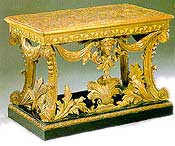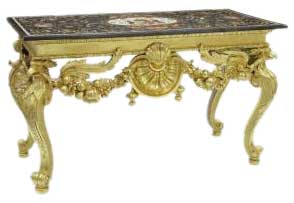Georgian Furniture
Early Georgian
For much of the early Georgian period of English furniture history the styles that had come to the fore in the Queen Anne period and before continued in popularity and underwent modifications of their own.
Mahogany
The most important change that occurred in the reigns of the George I and George II was the replacement of walnut by mahogany. Mahogany rapidly won favour among cabinet makers due to it being very strong, long lasting and having close grained wood well suited to experimentation. Mahogany was less prone to infestation, didn't scratch, crack, or warp, didn't need varnishing, and its dark reddish colour suited the design temperament of the early Hanoverian age.

Gilt Wood Side Table, in the Palladian Style, 1750.
Palladian Style Furniture
One such cabinet maker who took to the use of mahogany was William Kent. Kent, like many of the early Georgian period had gone on the Grand Tour to Rome, and there had taken up the Italianate architectural ideas of Andrea Palladio, an Italian architect of the sixteenth century, called Palladianism.

Italian Palladian Console Table by William Kent, c. 1730.
Architecture and Furniture
Architecture and furniture have always had a close relationship but in the designs of the Palladians and their imitators in early 18th century England this relationship became a deep intertwining, a pervasive and dogmatic ideology, the "Rules of Taste".
The original architects of the Palladian style had made no designs for furniture, being more interested in the overall layout of buildings, grounds, and gardens. Furniture was a mere addition and had to be in line with the other elements. Therefore Kent set about creating a style of Palladian furniture that would compliment and blend in with the Palladian architecture of great homes and their interiors, enhance their architectural symmetry, and be complementary to their existing windows, doors, chimney pieces, and cornices.

Early Georgian Bookcase by John Channon, 1740.
The "Kentian" furniture that resulted was ornate, of monumental size, heavy, only barely movable with lavish carving and golden ornamentation. It was sculpture like and could have just as easily been carved out of stone as of wood. Palladian style furniture made much use of elaborate pediments, masks, and sphinxes.
Common items included side tables, especially pier tables, usually with marble tops, chairs peaked with shells and legs graced with fish-scaled scrolls, as well as bookcases and gilt mirrors.
These designs were largely inspired by classical architecture elements such as moulded doors, large pediments, and various sculpture forms of the ancient world.

Miniatures Cabinet, inspired by Palladian architecture, 1743.
Palladian style furniture stood apart from most other early Georgian furniture in that it was designed and made for a small, very wealthy class of people and appeared only in their great country homes, mansions, and palaces. It had, as a consequence, little lasting influence, never making the leap to common use and acceptance.
When taken out of its context, away from the matching interior decoration of the rooms it was designed for, Palladian style furniture may seem to us bizarre, too big, and grotesque, very far out of tune with the modern taste.

Early Georgian Side Table, A more feminine, less architectural model. With scagliola top, c.1735.
Apart from William Kent other designers of this time who did at least some Palladian style work were Benjamin Goodison, James Moore, Giles Grency, and John Channon.
